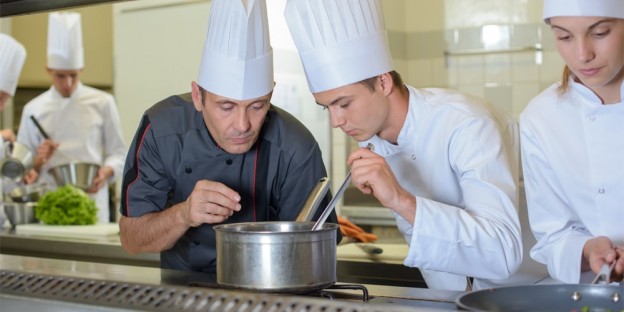Regular passengers would be baffled by the thought of imagining how a cruise ship kitchen works. A floating hotel that sails over days on glassy seas is indeed an idea of ingenuity in the hospitality world. But over decades, the art of storing, cooking and serving sumptuous food by cruise ship chefs has been perfected to a point that its modus operandi has fascinated all who love good food.
So how does a cruise kitchen serve thousands of meals each sitting and guarantee that every passenger has his or her fill, enjoys the food and often comes back for more? The key is cooking for the masses. While the look and feel says gourmet, the basic preparations are made with numbers in mind. So even though a passenger’s crème brulée might come served in an individual ramekin, the mixture is made – along with a thousand others – in a vat.
Food on a cruise ship is measured by the ton, with some reported figures being 60 tons for a 10-day supply. Staff works in tandem with suppliers to receive the stock on time, and usually forklift the huge load onto the ship at port. At the start of each cruise run, fridges and pantries are filled to the brim with stock, categorised according to type. To ensure, top quality, a specially employed person will check each consignment – of everything from tomatoes, eggs, fish fillets and flour to caviar, liquor, chocolate and sprinkles – so that nothing mediocre even reaches the kitchen.
Freezers and refrigerators are often numbered, with one or two saved for prepared plates. Sides like cold salads are prepared and left in the fridge for the chefs to simply plate up and speed out of the kitchen so guests are not kept waiting.
To make sure ships get their consignments on time, the cruise company selects suppliers at least three months in advance. Come rain, wind, snow or shine, the supplier must ensure his/her stock reaches the port at the time discussed. If consignments are delayed, or even part of the stock is late, the supplier will have to get it across to the ship at the next location on his/her own expenses.
With so many thousands of passengers, the amount of food and number of dishes prepared is staggering. Cruise ship kitchens have transformed from boring galleys serving a sloppy mess of food to spick-and-span operations dishing out meals worthy of reviews. To keep on top of it, staff works round the clock. Due to the volume, there could be a few people solely dedicated to doing a single task – such as cutting onions, boning beef or washing lettuce.
To maintain consistency among chefs in different shifts, some cruise kitchens tape up images of the final look of each finished dish. And to save space, everything is made from scratch, from sauces and mayonnaise to birthday cakes each day.
Some food gets special treatment on board – caviar and foisgras, which can cost quite a bit, are often stored under lock and key. Sometimes, as on the Regal Princess, even much-lovedNutella and Oreos are kept under a watchful eye! After all, they are the ultimate comfort food of all ages.


